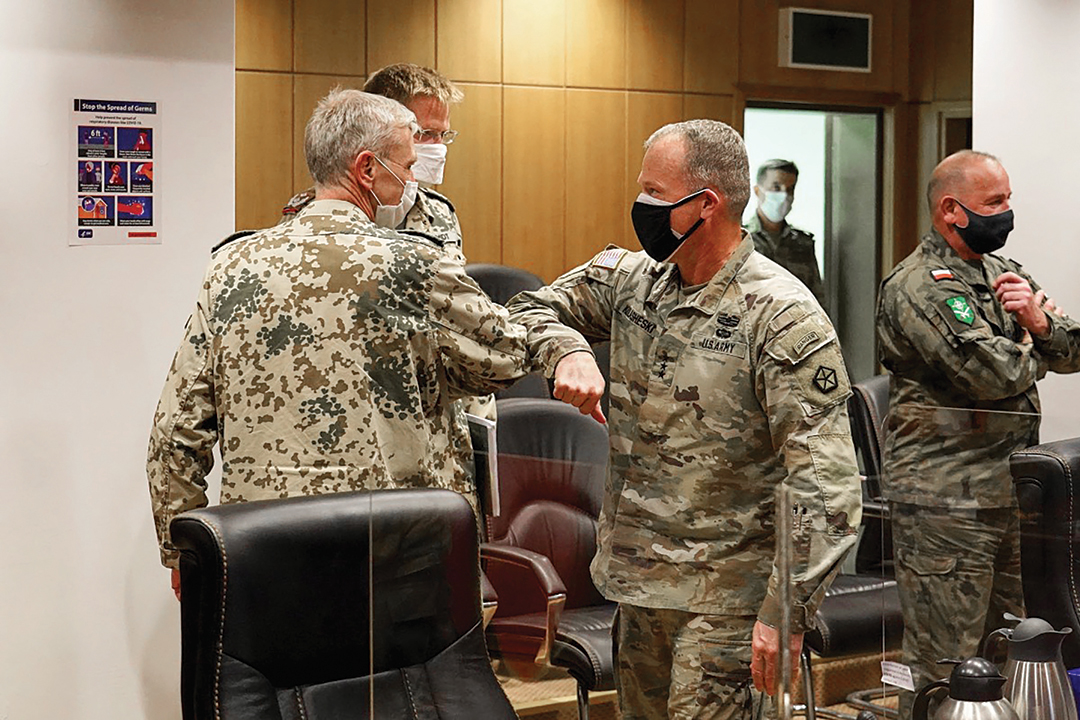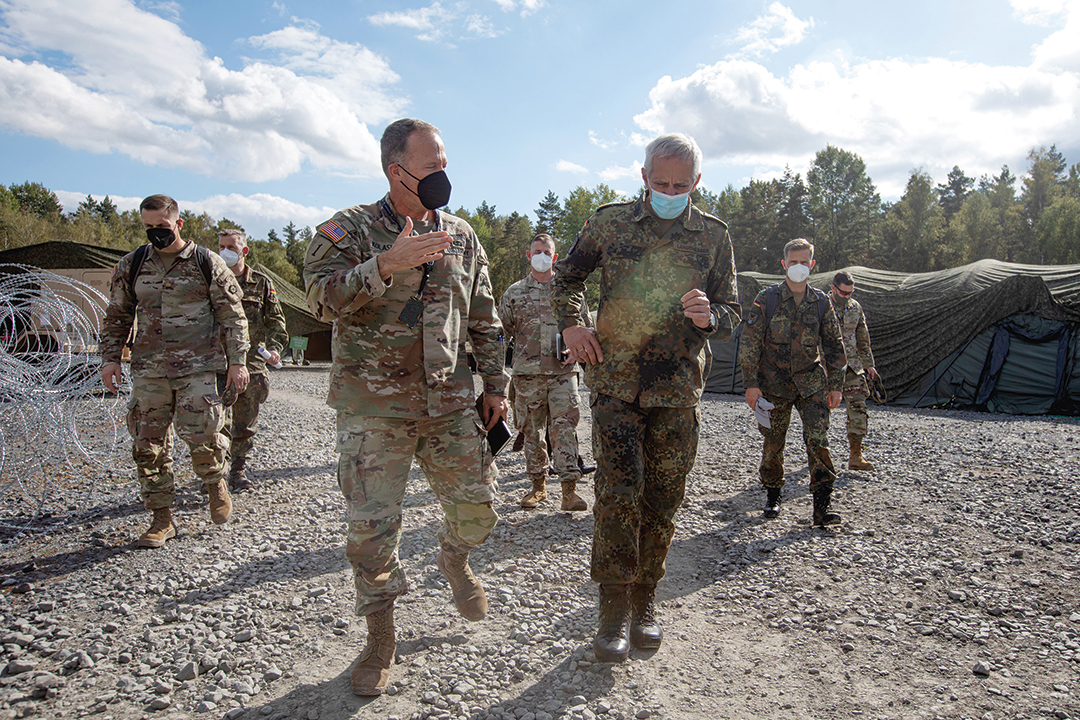 Lt. Gen. John S. Kolasheski assumed command of U.S Army V Corps in Fort Knox, Kentucky, in the United States, in 2020. The V Corps (pronounced Fifth Corps) was active during World War I, World War II, the Cold War, the Kosovo peacekeeping mission and the war on terror.
Lt. Gen. John S. Kolasheski assumed command of U.S Army V Corps in Fort Knox, Kentucky, in the United States, in 2020. The V Corps (pronounced Fifth Corps) was active during World War I, World War II, the Cold War, the Kosovo peacekeeping mission and the war on terror.
Let’s start with a brief look at V Corps. Where did it begin, where has it participated over the years, and why was it reactivated?
Lt. Gen. Kolasheski: Thanks for the opportunity to discuss V Corps. As you probably know, V Corps has a long history in Europe and has supported the European theater for just over 100 years, so this is kind of a “Back to the Future” moment. It’s an exciting moment. Since its founding on July 7, 1918, V Corps has served in some of the most important and difficult campaigns. It was instrumental in World War I, where it saw action in the Lorraine, St. Mihiel and Meuse-Argonne campaigns. The Corps earned the nickname Victory Corps as a result of the heroic efforts of soldiers during these battles. In World War II, V Corps took part in the D-Day invasion, and ultimately the liberation of Europe. Our allies and partners, as well as many others across Europe, are excited to see Victory Corps again.
V Corps was reactivated after strong demand signals from both U.S. European Command (EUCOM) and the U.S. Army Europe and Africa to provide a needed level of command and control, focused on synchronizing U.S. Army, allied and partner nation formations operating in Europe. Our senior leaders have made clear that V Corps’ return is about demonstrating the U.S. commitment to Europe, to NATO, and to our allies and partners in the region. At the same time, the reactivation also serves as a reminder that the operating environment has changed; competition is the norm, and V Corps’ existence is a testament to our recognition of that.
As you say, a renewed focus on competition has been a catalyst for change within both Europe and the U.S. defense establishment. From your perspective, what does the reestablishment of V Corps mean to U.S. European Command, U.S. Army Europe and Africa, and NATO allies and partners?
Lt. Gen. Kolasheski: V Corps provides a ready and rapidly deployable, three-star, warfighting headquarters capable of operational planning, mission command and oversight of rotational forces in Europe. V Corps’ reactivation is a big, big deal for U.S. European Command, the Army, Forces Command, U.S. Army Europe and Africa, and our allies and partners. The reactivation of Victory Corps is clear and tangible evidence of the U.S. commitment to NATO and the European community of nations.

From large-scale training exercises to small social events to key leader engagements with our NATO allies and partners, the mutually supportive relationships we are forming across organizations, commands and nations help generate tangible progress on interoperability that is critical to a ready and cohesive alliance. Interoperability for V Corps spans the human, procedural and technical domains, with the ultimate goal of providing combat-credible forces to deter adversary aggression in the region.
V Corps’ presence in Europe is a continual reminder that we are stronger together. This is why interoperability is so important. Our allies are indispensable and our cooperation magnifies each of our unique strengths and advantages against potential adversaries. As we continue to train alongside allies and partners, we are looking at areas for further integration and greater interoperability to set conditions for the future. We know we won’t fight alone. We will fight as part of a coalition, which is why strong relationships matter. Together we are better prepared to impose costs upon any adversary that might threaten peace and prosperity in Europe, which is a vital aspect of deterrence.
What are V Corps’ priorities for the short- to mid-term in establishing V Corps in the European theater?
Lt. Gen. Kolasheski: I am focused on helping the commander of the U.S. European Command and NATO’s supreme commander in Europe, and the commanding general of the U.S. Army Europe and Africa, to meet our national defense requirements here in Europe, show U.S. resolve and U.S. commitment to our allies and partners. With that, I have established three priorities for the Corps in the short term to ensure we maximize our efforts and produce positive effects.
My first priority ensures the Corps maintains a “people first” mindset. We accomplish this through engaged leadership and predictability, which allows us to form a team built on competence, resilience, discipline and trust. This in turn fosters our ability to collectively adapt and innovate, giving us an advantage as we promote regional security while enhancing our readiness and ability to support allies and partners.
My second priority is to constantly consolidate gains, day to day, in all we do while enhancing our collective position. This means strengthening relationships and deepening our military capabilities that ultimately contribute to national and regional security. If done deliberately, when called upon, we will be able to generate windows of advantage that can be exploited (by ourselves and our partners) and achieve real effects on the battlefield.
My third priority is remaining focused on our enduring mission, which is, to put it simply, to exercise responsibility for designated forces in Europe. Vital to accomplishing these priorities is our forward element in Poznań, Poland, which helps me ensure the readiness of our forces and is essential in establishing our presence in the European theater. What is known as V Corps Forward allows us to live in what I call “the contact layer” and provides me with an indispensable level of situational awareness.
How will V Corps shape the operational environment with other allied and partner nations?
Lt. Gen. Kolasheski: First, we have an enduring presence in Europe, thanks to our Corps Forward in Poland. This allows for rapid theater engagement and mission command of forward deployed subordinate commands while monitoring current operations throughout the European Theater of Operations. Our Corps Forward will execute engagements and select responsibilities throughout the V Corps European area of operations and as an extension of the Main Command Post headquarters in Fort Knox, Kentucky. I will stress, though, that the Corps Forward does not do this alone. The Main Command Post is the integrating headquarters, constantly and continuously directing and supporting the Corps Forward with planning and resourcing.
I mentioned it earlier but want to reiterate it: We are never going to fight alone. Our relationships with allies and partners strengthen a foundation built upon resilience, innovation and shared vision. We must depend on each other in ways that emphasize and leverage our core strengths, ultimately honing our competitive advantage against adversaries. In conflict this allows us to simultaneously present multiple dilemmas to our adversaries. At the same time, during competition we are shaping the operational environment to deny positional advantages to the adversary and interrupting his decision-making cycle.
Allies and partners play a big part in allowing V Corps to compete daily in the contact layer. Interoperability is key to successful deterrence and that is part of the reason I stress it so much to my team. It increases allied flexibility and enhances existing capabilities. Interoperable combined forces can effectively act together to more easily achieve military objectives. This is interoperability, and it is a priority initiative for V Corps. We are incorporating it into our plans, daily operations, communications, information sharing and equipment. The chairman of the Joint Chiefs of Staff, Gen. Mark Milley, has made clear that the need for interoperability extends beyond the battlefield. V Corps is taking that need and making it a reality.

Multi-Domain Operations (MDO) has been a big topic of late; how will it work in Europe, and what role will V Corps play?
Lt. Gen. Kolasheski: Part of MDO is integrating and converging lethal and nonlethal effects against targets across the various domains, including the physical and information environments. We have learned from recent conflicts that this integration is critical to our battlefield success. V Corps now has the opportunity to continuously improve on this integration and leverage it within the European Theater. The benefits of convergence are real. We saw this during our exercises this past year, especially during our culminating Warfighter exercise in October 2021. This is what I see as essential, new and different with MDO. We will employ integrated effects across the competition continuum in Europe, not just in large-scale combat operations.
MDO is important, even critical, because our adversaries and competitors are contesting all domains, not just during conflict, but also right now. In recent years, our adversaries have exploited seams and gaps within the operational information environment by competing below the level of armed conflict. This tactic has been successfully used around the globe. Smaller armies and groups are now capable of fighting on an expanded battlefield that is increasingly lethal and hyperactive. Nation states are having more difficulty imposing their will within a politically, culturally, technologically and strategically complex environment. Near-peer states are exploiting ambiguity below armed conflict, making deterrence more challenging.
Nations like Russia frequently use gray-zone activities, including unconventional and information warfare to propagate a narrative favorable to their strategic objectives. Mastering multidomain operations with allies and partners is crucial to winning any future fight, as well as competing below the level of armed conflict. Our planning and operations cycle is being adapted to enable us to focus efforts where we assess the competitive space, anticipate changes in the environments and influence outcomes.
How do you view the challenges and opportunities that V Corps faces?
Lt. Gen. Kolasheski: Our adversaries believe that the very rules of war have changed. There is a recognition that nonmilitary means of achieving strategic goals have grown in importance and, in many cases, exceed the power and speed of direct military force in their effectiveness. When looked at through this new prism, one can see how V Corps plays a critical role in helping the U.S. and NATO face the challenges of today and tomorrow.
Future warfare is now about the multidomain fight. Near-peer competitors are synthesizing emerging technologies to exploit perceived seams in the Alliance and complement their military operations and doctrine. Those technologies are capable of deploying and challenging the U.S in all domains. The military problem we face is defeating multiple layers of stand-off capabilities across all domains while at the same time maintaining coherence of our operations.
By continually working with our allies and partners, we’re creating an environment that reaffirms, modernizes and reinvests our Alliance as our greatest strategic asset. Together we contribute to a common front and a unified vision, working hand in hand to advance shared interests and values, giving us a unique advantage in modern competition. V Corps has had a fast-paced first year, starting with reactivation, operating in the COVID-19 environment and completing a rigorous series of exercises. We will not be resting on our laurels any time soon. I’m looking forward to contributing to strengthening the capabilities of U.S. EUCOM, the United States and the entirety of the NATO Alliance.
STRONGER TOGETHER!
IT WILL BE DONE!
VICTORY!
Editor’s note: This article was completed prior to Russia’s illegal escalation of aggression against Ukraine in February 2022.


Comments are closed.